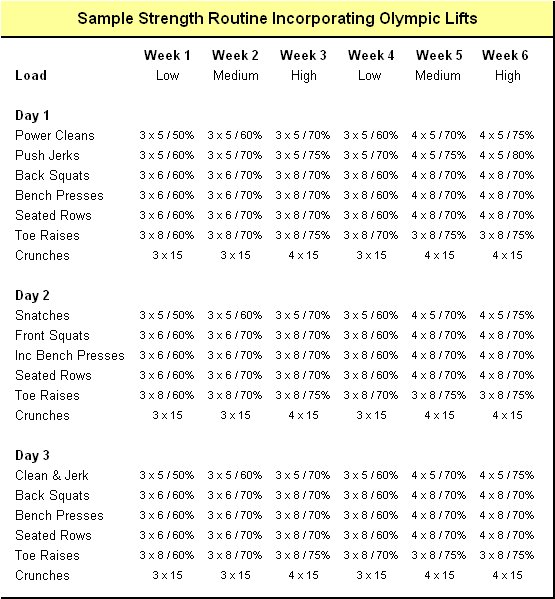This Olympic weightlifting routine is an example of how Olympic-style lifts can be incorporated into a strength training program.
It is designed for individuals who have little Olympic lifting experience but who do have a significant strength base.
It is essential that younger and less experienced strength trainers follow an anatomical adaptation strength phase to prepare muscles, ligaments and connective tissue for more strenuous training such as this. This sample Olympic weightlifting routine presupposes the athlete has recently completed at least 12 weeks of foundational strength conditioning.
Olympic weightlifting is often confused with powerlifting. Powerlifting is not an Olympic sport and consists of three exercises – bench presses, squats and dead lifts. Unlike these three exercises, the two lifts contested in Olympic weightlifting – the snatch and clean & jerk – are rarely seen performed in modern day gyms.
Perhaps the main reason is due to their complexity and the space required to complete the lifts safely. It’s a shame however, as contrary to some misguided beliefs, Olympic-style weightlifting under correct instruction is very safe and can offer some athletes great performance benefits…
Should Athletes Adopt Olympic-Style Lifting Into Their Routine?
Olympic weightlifting routines and exercises are finding themselves into more and more sports training programs. While they can offer advantages to some athletes, they are far from the magic bullet that many strength and conditioning experts claim.
Olympic-style training may be more sport-specific than a bodybuilding program design, however when training time is limited only the most relevant exercise selection will do.
For example, exercises such as power cleans work the hip extensors. Sports such as judo work predominantly the hip flexors so are they really relevant? Even in sports that do stress the same muscle groups as cleans, there are often more efficient and specific exercise choices.
Even if one Olympic-style movement is sport-specific that doesn’t mean they all are. A carefull needs analysis should be the first step in the design of any sports strength program, and it’s in this early stage that it becomes clear that Olympic lifts aren’t always appliable.
No Substitute For Proper Coaching
Compared to traditional weightlifting exercises, such as bench presses, squats and shoulder presses, Olympic lifts and associated lifts are complex movements. They require the co-contraction of several large muscle groups in the right sequence. Additionally, they must be performed quickly and with correct technique in order for the lift to be completed successfully. To that end, coaching from a qualified instructor is more important in the first phase than loading patterns and volume.
Before any amount of significant weight is added, athletes should practise Olympic-style lifts until co-ordination and technique is correct. However, it can be difficult to perform the lifts correctly with a light weight on the bar (< 30% 1-RM) due to difficulties controlling deceleration of the bar at the end of the movement. Load should be increased gradually and sets should not be completed to failure.
Load, Sets & Repetitions in an Olympic Weightlifting Workout
As mentioned earlier, athletes not used to Olympic lifts should use a light enough weight so that technique is correct. Progression in the early stages should be gradual and in small enough increments that the lifts can still be performed with correct technique.
Eventually, when the athlete can competently lift relatively heavy loads, target repetitions should be in the 3-5 per set range with loads of 75-85% 1-RM. Normally, with exercises such as bench presses and squats, loads in the region of 87-93% 1-RM can be lifted for 3-5 repetitions. Peak power however, is achieved with moderate, not maximal loads, executed with a fast tempo. By using a load of 75% 1-RM (which would permit 10 repetitions with most traditional weight lifting exercises) and completing a maximum of 5 repetitions, proper form and speed of execution can be maintained.
About 3-5 sets of each Olympic-style lift is adequate and rest intervals should be long enough to promote almost complete recovery between sets. Recommended rest interval time is 2-5 minutes.
See the power training article for the guidelines governing load, sets and repetition parameters.
Sample Olympic Weightlifting Routine
The following Olympic weightlifting routine is not sport-specific. It serves simply as an example of how Olympic-style lifts can be combined with traditional weight training exercises in one program.

In the table above where sets, repetitions and load is expressed as “3 x 5 / 50%” this equates to 3 sets of 5 repetitions with a load of 50% 1-RM.

Jacky has a degree in Sports Science and is a Certified Sports and Conditioning Coach. He has also worked with clients around the world as a personal trainer.
He has been fortunate enough to work with a wide range of people from very different ends of the fitness spectrum. Through promoting positive health changes with diet and exercise, he has helped patients recover from aging-related and other otherwise debilitating diseases.
He spends most of his time these days writing fitness-related content of some form or another. He still likes to work with people on a one-to-one basis – he just doesn’t get up at 5am to see clients anymore.